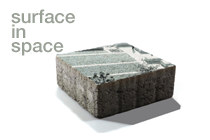Lecture
surface in space
Image / Technology

surface in space
A series of lectures organised by the Architekturzentrum Wien in partnership with Zement + Beton and der ARGE Fläche.
Following last year’s differentiation of spatial types in public space, the series of lectures Surface in Space 2003 is focusing on concepts, production strategies and modes of perception for contemporary landscape.
The sites are the result of practical experience gained over the last twenty years of landscape design, adopting ambiguous forms and as an intrinsically contradictory construction process in the no-mans-land of the superseded duality of rural urban space.
The terms memory / identification, integration / scenography and image / technology serve as leitmotifs for the series of lectures discussing current experiences in and approaches to the working of landscape, its symbolic pictorial repertoire, its ‘invisible’ social and cultural functions as well as the technological and medial permeation of the natural.
“Landscape architecture has, until now, only reluctantly had anything to do with the aesthetics of technology, and developed into a profession based upon the romanticisation of the past. But for our own best we have to learn to see our landscapes without sentimentality.” Martha Schwartz
“The reason the potential dialectic inherent in the picturesque broke down was because natural processes were viewed in isolation as so many classifications, detached from physical interconnection, and finally replaced by mental representations of a finished absolute ideal.” Robert Smithson
Greeting
Dietmar M. Steiner, Architekturzentrum Wien
Karl Weissenböck, ARGE Fläche
Felix Friembichler, Österreichische Zementindustrie
Michel Desvigne (Desvigne & Dalnoky), Paris
Greenwich Peninsula Park, London, 1998 – 2000
The course of the Thames forms a peninsula that has been the site of brisk industrial activity over the past few decades. The Millennium celebrations triggered off a new building initiative there. The now extinguished industrial activity that arose in the area has left the ground heavily polluted. The soil has been excavated, carried away and replaced to a depth of up to two metres. The result was a kind of tabula rasa upon which a concept has been conceived. Digging up the ground is an “unusual and disconcerting act”, eradicating all traces of previous life there and so, according to Michel Desvigne, preventing the restoration of the landscape with usual means. It is actually the case that in Greenwich Peninsula Park nobody was able to resort to the usual images of projects for public parks that re-establish the historic and now lost trappings: lakes, theme gardens and monuments.
Lecture Olivier Philippe (Agence Ter), Paris
Agence Ter, French Guiana, Cayenne, since 1994
The course of the Thames forms a peninsula that has been the site of brisk industrial activity over the past few decades. The Millennium celebrations triggered off a new building initiative there. The now extinguished industrial activity that arose in the area has left the ground heavily polluted. The soil has been excavated, carried away and replaced to a depth of up to two metres. The result was a kind of tabula rasa upon which a concept has been conceived. Digging up the ground is an “unusual and disconcerting act”, eradicating all traces of previous life there and so, according to Michel Desvigne, preventing the restoration of the landscape with usual means. It is actually the case that in Greenwich Peninsula Park nobody was able to resort to the usual images of projects for public parks that re-establish the historic and now lost trappings: lakes, theme gardens and monuments.
Moderated by Maria Auböck, Landscape architect
